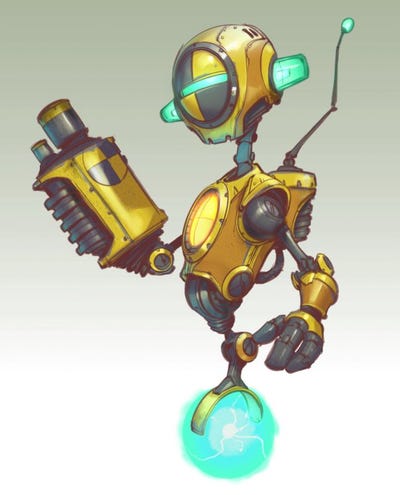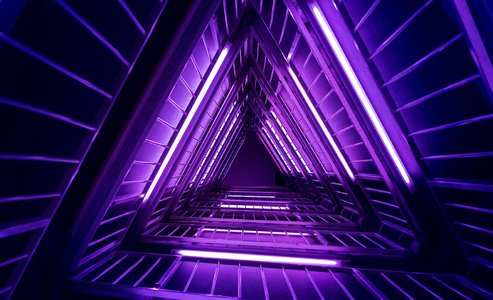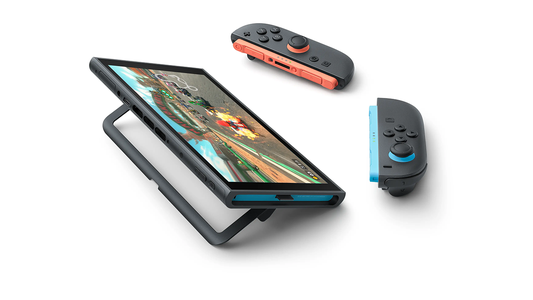Shaun McCabe is the game director for Ratchet & Clank (PS4), and the production director at Insomniac Games’ studio in Durham, North Carolina. Chad Dezern is the Creative Director for Ratchet & Clank (PS4), and the studio director of the North Carolina location. The two also co-directed Ratchet & Clank: All 4 One (2011), Ratchet & Clank: Full Frontal Assault (2012), Ratchet & Clank: Into the Nexus (2013).
***
Sure, it seems obvious now. Of course there should be a Ratchet & Clank game to tie in with the major motion picture. But Ratchet & Clank for the PlayStation 4—designed as a killer one-two punch alongside the film, the ultimate version of an origin story—didn’t always seem like such a great idea.
Of course, we were thrilled when we heard that the film was a go. We’ve long felt that Ratchet, Clank, Qwark, and their Solana galaxy milieu had all of the action, humor, pathos, and just plain
. . . bigness . . . to populate a feature. Or six. Hey, it’s a big universe.
But the prospect of making a film tie-in was especially daunting.
First, we had the legacy of the series to consider. This one needed to be a major step forward, but it also needed to retain the soul of the original game. We had 10 Ratchet games under our belts at that point, across the full spectrum: story-driven single player epics. Single player/competitive multiplayer hybrids. Couch co-op. Experiments in form. Experiments in scale. We’ve had universal successes and noble failures. The most recent title, Ratchet & Clank: Into the Nexus, was mostly well received, earning the backhanded compliment/upbeat critique “it was too short, we wanted more.” Okay. We’ll need to make sure the eleventh one is suitably epic.
"We needed to make a big game that blew away our previous efforts. It needed to sync up with the just-getting-started film. And we needed to ship it in 10 months to line up with the movie release."
Second, there was the prospect of syncing up with film production. What did co-development of a game and film really mean? A lot of variables, that’s what. Sure, the film is based on the original game, and pulls some models from our asset libraries. But the script was in flux (rightly so, it was just getting started). And early conversations pointed to a major cleanup of the backstory, a rework of the character lineup, and the introduction new locations. How would we work out a game macro around that?
And finally, there was our second oldest arch-nemesis, time itself*. We needed to release the game day-in with the film, and time—that grumpy, no-good jerk—was unforgiving. We curled up in fetal positions and hid under our desks for a while.
But ultimately, we uncurled ourselves and climbed up on top of our desks because we love making Ratchet & Clank games. And so do a lot of other people at Insomniac. Even after 16 years, there is tremendous interest and excitement in the series. We all grew up doodling robots, reading science fiction, and watching Star Wars, Back to the Future, and Ghostbusters; it’s safe to say that we were deeply affected by the sense of wonder and fun in that particular strain of summer movie sci-fi.
So, we needed to make a big game that blew away our previous efforts. It needed to sync up with the just-getting-started film. And we needed to ship it in 10 months to line up with the movie release. **
Okay. We’ll stop whining. We love Ratchet & Clank. Sign us up.
*Our oldest arch-nemesis is a man named Paxton Crowlers.
**This changed, thank goodness.

WHAT WENT RIGHT
1) Balancing the old and the new
Within the first 30 seconds of our first conversation about Ratchet & Clank on the PlayStation 4, we knew that we didn’t want to make a remaster or an up-res.
We wanted to apply everything that we’ve learned over the past 15 years. The original game is very much a platformer first and a shooter second. Shooting used a hero-facing mechanic that made it pretty difficult to aim; consequently, there were slower rates of fire, lower ammo counts, and fewer enemies. The weapons that are now the hallmark of the series felt more like gadgets that blew stuff up. Modern third-person shooters are more refined, with a seamless integration of camera and reticle. We felt like it was our sworn duty to modernize the controls, to design the game around a fun and fluid shooting mechanic--but that meant a rework of every weapon, enemy, and setup in the game. It meant effectively rebuilding everything.
Yet we couldn’t imagine a take on Ratchet & Clank that didn’t include hoverboarding on planet Rilgar, infiltrating the Ion Turret on Batalia, or swimming underwater at the Pokitaru resort. We wanted to keep most of the original planets intact, to hit the nostalgia button for our fans and to keep our production time manageable.
 We ended up building a new game on top of the original foundation. We started with the main story beats. We chose Ratchet’s home planet on Veldin, Aleero City on planet Kerwan, Drek’s Warbot factory on Quartu, and Drek’s Deplanetizer orbiting weapon as our main locations. These would be shared between the game and film, so we reworked each layout from top to bottom (in the case of Veldin and Aleero City) or designed the location from scratch (in the case of Quartu and the Deplanetizer).
We ended up building a new game on top of the original foundation. We started with the main story beats. We chose Ratchet’s home planet on Veldin, Aleero City on planet Kerwan, Drek’s Warbot factory on Quartu, and Drek’s Deplanetizer orbiting weapon as our main locations. These would be shared between the game and film, so we reworked each layout from top to bottom (in the case of Veldin and Aleero City) or designed the location from scratch (in the case of Quartu and the Deplanetizer).
These became our narrative tent poles, matched as closely as possible with the film. Our longtime SCEA producer Greg Phillips was invaluable here; he’s a bottomless well of Ratchet & Clank knowledge.
With the big story points established, we created the gadget-driven progression scheme that opens up new planets. We pulled heavily from the original game. But we gave ourselves permission to diverge. We like the open world planets that started showing up in later games, and we like the jetpack mechanic that we developed for Ratchet & Clank: Into the Nexus. So we expanded planet Gaspar with a huge new jetpack area. The film has an action set-piece ship combat sequence in Aleero City. So we added that, too. We threw a boss battle into the Blarg Research Station because we don’t know when to stop.
After we established the macro design, we realized that we could get a leg up if we used some of the original layouts. So we enlisted help to extract our PS2 level data and import it into our engine (no easy feat, thanks to questionable archival practices; see “what went wrong”). When designers and environment artists moved on to the project, they started with perfect 1:1 replicas of all of the locators and instances from the original. That sped up normally time-consuming design iterations. We spent our bandwidth scripting encounters and polishing enemy setups for the new control scheme instead of grappling with fundamental layout issues.
All told, the final game included modern controls, two new planets, three extensively reworked planets, eight returning planets, a new weapon arsenal, new Clank gameplay, new space combat, new boss battles, and a new weapon arsenal, all wrapped in a structure that matches the film and also represents our best attempt at capturing the soul of the original game.

2) The game based on the movie based on the game
The film is based on Ratchet’s origin story from the PlayStation 2 game. Ratchet is a Lombax orphan mechanic. Clank is a robot factory defect. The two meet when Clank’s escape pod crash-lands on Ratchet’s adopted home planet.
But the story diverges after that. The film tells a story that is more character-driven and accessible than the (admittedly somewhat rambling) original game—Ratchet is nicer to Clank. Clank’s origin story is easier to understand. There are more secondary characters and fewer planets.
The new game’s macro needed a dramatic revision to match. It had to stand on its own. But it also had to line up perfectly with the film’s re-telling of the story. We couldn’t have mismatched writing, plot points, or visuals.
No tags.





































